To go big, action sports stars call ramp builder supreme Nate Wessel

When a BMX rider pulls an improbable trick, landing in the record books, or when the roar of the crowd drowns out the PA system in a packed arena after a skater gets wildly creative in the air, the focus is on the athlete in motion. But to attain the amplitude that sells sports drinks, these athletes need ramps with the finest, most precise engineering available in the industry. And not just for that amplitude but for their own safety as well. That’s when they call Nate Wessel.
“Nate’s ramps come to life,” says Travis Pastrana, who works with Wessel on his Nitro Circus tour. “And that’s because of his riding skills and knowledge—he can assess and change the minor flaws that inevitably make a huge difference in the feel and flow of a park [or ramp].”
Wessel, 39, grew up in Bay Village, Ohio, and was always a skateboarder. He picked up BMX in his teens and quickly became a rider’s rider, putting in serious time—and logging serious hours in the ER. Wessel estimates that he has been concussed some 30 times during his career. Aside from head injuries, he has blown out knees and had a wood chip penetrate his eyeball, a mishap that necessitated emergency surgery. Wessel likes to say in interviews that he could never be a pro rider, so he took up ramp building. But that’s not entirely true. Videos of him shredding are all over the internet and he’s a gifted athlete—he earned a pole vaulting scholarship to Ashland University in Ohio.
But riding bikes is his passion, and in the mid-90’s, ramps used for BMX tricks were archaic at best. After building a park in his hometown, Wessel attended Woodward Camp as a high schooler, an innovative action sports camp that he still works for today. Though he had no training in mathematics, engineering, or construction, the camp heads quickly moved him into a ramp-building position in which he worked under Matt Hoffman and Jay Mira to construct Woodward’s skate and BMX park, basically because he showed passion and a hint of natural talent.
“We were all sitting in a room there talking how awesome it would be to build this and that, and I was like, ‘Let’s do it. All we need to do is get this, you do this and I’ll do the rest’,” Wessel says. “I built everything they threw at me and had no idea what I was doing but I learned a lot working with those guys. I was a sponge.”
Then Wessel got the opportunity that he says blew his career wide open—to engineer the Chenga Park, an iconic BMX and skate park in North Ridgeville, Ohio. Following his freshman year in college, he’d heard about the indoor facility in an industrial area 50 minutes from where he was going to school at Ashland. He couldn’t afford to pay the membership fees so he offered up his services as a ramp builder to foot his bill. He started with simple box jumps and quarterpipes, trying to convince owners Scott Powell and Dave Schaefer to let him do more. Wessel had ridden outdoors extensively at such places as the legendary dirt jumps of P.U.S.H., a hardcore, underground BMX trail system in Pittsburgh built by the employees of that mid-’90s clothing brand, and Posh, another underground rhythm system in Bethlehem, Penn.—places where riders could push the BMX envelope. Wessel had a vision.

Finally, during a week when Powell and Schaefer were out of town, Wessel went to town on the indoor park, essentially creating the first series of indoor rhythm jumps that flowed like a trail. “Those guys gave me the opportunity to experiment and there was nothing like it anywhere,” he says. “It worked better than I ever could have imagined. Two hundred people would show up for a weekend and you’re like, ‘That’s too many people.’ In a bowl you have one person going at a time and 10 on deck. With flow trails you could have 60 people riding at the same time. It was a one-o-a kind park and people still talk about it all the time.”
After word got out on Chenga, Wessel started getting calls from around the world. The X Games soon rang and he would spend seven years with one of action sport’s most important franchises.
“I kind of helped X Games build into the more core aspect of what was happening in skate and BMX at the time,” he says. “I wasn’t a big fan of the style of ramps they were using. I liked all the other contests, but there wasn’t an event holding it down for those sports. [I feel like I] helped X Games get to that and I really enjoyed it.”
These days, Wessel is still making specialized ramps for some of the sport’s biggest projects, like Jed Mildon’s and James Foster’s attempt to be the first BMX riders to complete quadruple backflips, or projects for television shows like Stunt Junkies. Wessel has made lots of friends over the years, and he’s known for going out of his way for them.
When Josh Sheehan was working on the first triple backflip on a motorcycle this spring, Wessel was at Pastrana’s Nitro Circus compound in Maryland working on the ramp for two weeks. Late in the day, Wessel was about to drive back to Pennsylvania for his anniversary—he and his wife, Ashlee, have two children—when he noticed a problem with the ramp, jumped out of his car and spent another half hour fixing the problem, then took off to meet his family.
“Nate never misses an opportunity to be there for any athlete that wants to take their sport to the next level,” says Pastrana. “But at the end of the day, the only thing he loves more than helping his friends, or seeing action sports progress, is spending time with his family.”
